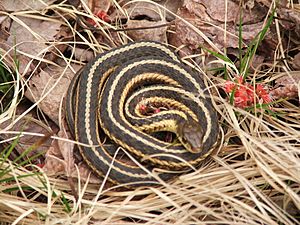Butler's garter snake facts for kids
Quick facts for kids Butler's garter snake |
|
|---|---|
 |
|
| Butler's garter snake | |
| Conservation status | |
| Scientific classification | |
| Genus: |
Thamnophis
|
| Species: |
butleri
|
| Synonyms | |
|
|
The Butler's garter snake (Thamnophis butleri) is a type of garter snake that lives in North America. It is part of the Colubridae family, which includes many common snakes. These snakes are known for their stripes and are not venomous. They are usually found in wet, grassy places.
Contents
What is a Butler's Garter Snake?
Butler's garter snakes are small and thin. They usually grow to be about 38 to 51 centimeters (15 to 20 inches) long. They have three yellow or orange stripes running along their body. The rest of their body can be olive-brown or black. Sometimes, you can see dark spots between their stripes.
How to Identify a Butler's Garter Snake
It can be tricky to tell Butler's garter snakes apart from other garter snakes. However, their side stripes are special. These stripes are centered on the third row of scales from their belly. They also slightly cover the second and fourth scale rows. This is different from how stripes appear on most other garter snakes.
Another clue is their head, which is quite small compared to their body. If you see one trying to escape, it might thrash around a lot instead of quickly slithering away.
Where Do Butler's Garter Snakes Live?
Butler's garter snakes are found in specific areas of North America. You can find them in northwestern Ohio, northeastern Indiana, and the eastern part of the Lower Peninsula of Michigan. They also live in the very southern tip of Ontario, Canada. There is also a separate group of these snakes in southeastern Wisconsin.
What is the Habitat and Diet of Butler's Garter Snake?
These snakes love moist, grassy areas with open spaces. This includes places like meadows, wet prairies, marshes, and grasslands. They can even be found in grassy empty lots in towns and cities. They often hide under rocks, logs, or other objects.
What Do Butler's Garter Snakes Eat?
Butler's garter snakes mainly eat earthworms. They might also eat leeches, salamanders, and frogs.
How Do They Live?
These snakes often hibernate together in groups, sometimes with other types of garter snakes. They do not live very long, and they are ready to have babies when they are about two years old.
How Do Butler's Garter Snakes Reproduce?
Butler's garter snakes give birth to live young, meaning they do not lay eggs. Mating usually happens in late March or early April. The baby snakes are born in June or July. A mother snake can have anywhere from four to 14 babies at once. Newborn snakes are about 13 to 18 centimeters (5 to 7 inches) long.
Why is the Butler's Garter Snake Endangered?
In some places, the Butler's garter snake is considered an endangered species. This means their numbers are very low, and they are at risk of disappearing. For example, they are listed as endangered in both Indiana and Ontario, Canada. Efforts are being made to protect their habitats and help their populations grow.


